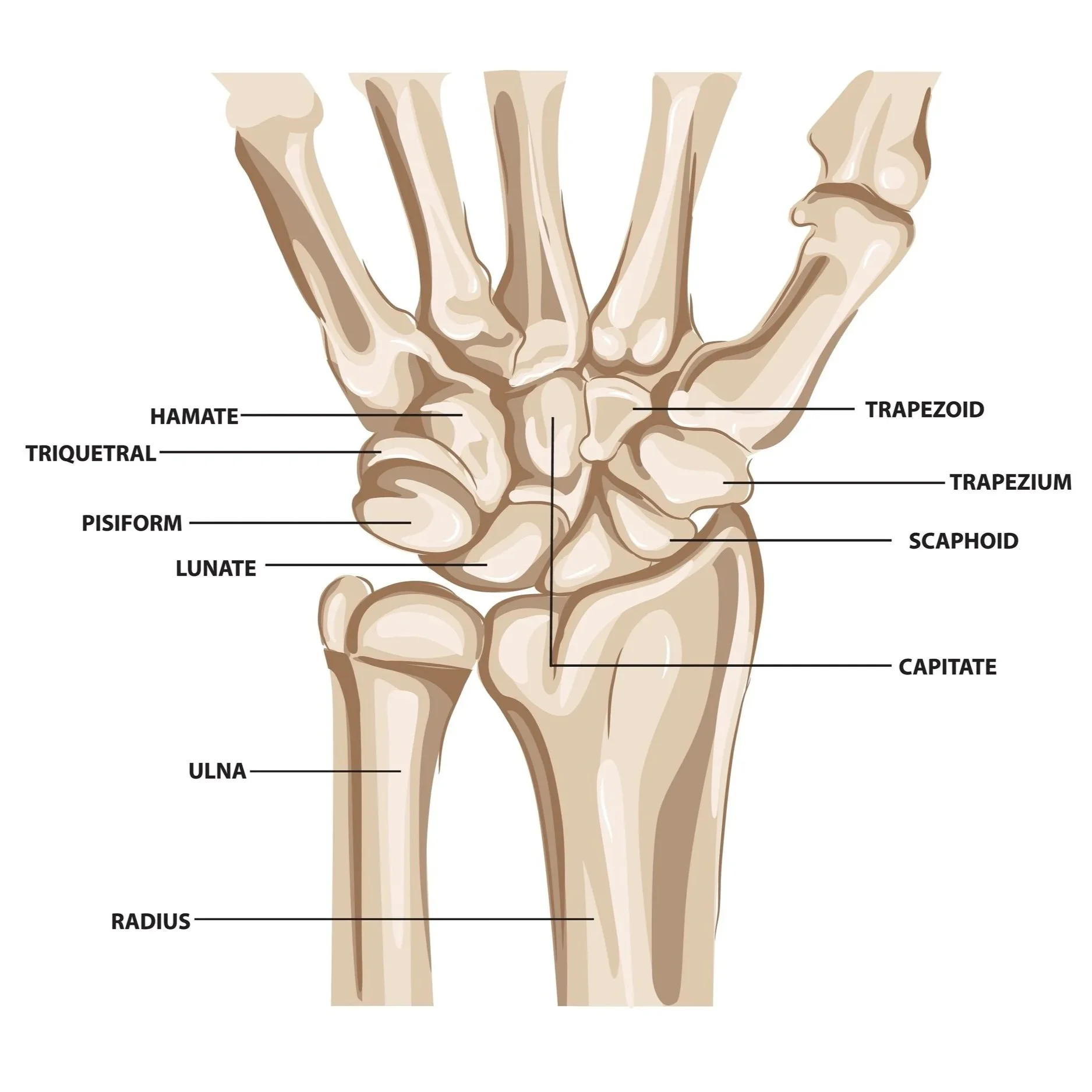Wrist Arthritis
What is wrist arthritis?
Arthritis is defined as the inflammation of one or more of your joints. It occurs when the cartilage between your joints breaks down, resulting in there no longer being a smooth gliding surface for the bones to move. The wrist is made up of smaller joints that work together to allow you to move your wrist. When arthritis affects one or more of these joints, you experience pain and stiffness and daily activities can become more difficult.
The three most common forms of wrist arthritis are osteoarthritis, rheumatoid arthritis and post-traumatic arthritis.
Osteoarthritis is the degenerative ‘wear and tear’ form of the disease that generally affects older people and typically appears in a predictable pattern in one or more of the joints in the wrist. It can also develop from Kienböck's disease, where the blood supply to one of the carpal bones — the lunate — is disrupted. This causes the bone to die and collapse. Over time, this collapse can lead to changes and arthritis in the joints around the lunate
Rheumatoid arthritis, by contrast, is a chronic autoimmune disease that causes swelling of the joint lining, which in turn, damages the cartilage over time. It can affect people in a wider age range and can be diagnosed through a blood test.
Post-traumatic arthritis is caused by an injury to the joint due to trauma, such as a broken bone or torn ligament, which results in degeneration of the cartilage, similar to osteoarthritis, and can be experienced years later.
Symptoms of a wrist arthritis
Arthritis can affect any joint in the wrist and causes the following symptoms:
Pain: In the early stages of wrist arthritis, you may notice a dull or burning sensation in the affected joint, which can often intensify after periods of increased joint use. As the cartilage wears away, you will notice the pain occur more frequently, and it is worse in the morning and/or with changes in weather.
Swelling: The wrist often swell after prolonged of heavy use.
Stiffness: There is often reduced range of motion in the wrist that is more noticeable when you first wake up in the morning.
Weakness of the wrist: You may feel like you’re unable to use your wrist like you used to because of weakness.
How Ben can help?
Diagnosing wrist arthritis
Ben will typically be able to diagnose wrist arthritis and/or assess whether surgical intervention is required by examining both the hand and wrist and assessing range of motion, tenderness, swelling and/or joint instability. He will also check nerve function to rule out carpal tunnel syndrome. Furthermore, he will usually order X-rays to learn more about the exact location and severity of your arthritis. Blood tests may also be necessary to determine which type of arthritis you have.
Treating wrist arthritis
Non-surgical treatment
There are a myriad of non-surgical treatments for wrist arthritis that will normally be recommended before surgical intervention. Usually these will be recommended by your GP and only once these treatments have been exhausted will a referral to Ben be necessary. These options include:
Medication
Splinting the wrist
Activity modification
Injections
Specific exercises
The non-surgical treatment option/s recommended to you will be based on:
How far the arthritis has progressed
How many joints are involved
Your age, activity level and other medical conditions
Whether your dominant or non-dominant wrist is affected
Your personal goals, home support structure, and ability to understand the treatment and comply with a therapy program
Surgical treatment
Ben will usually recommend surgery if non-surgical treatments have failed to provide pain relief. Surgery will be different for every patient and will depend on which wrist joints are affected and how far the arthritis has progressed. The tailored surgical approach will be explained to you by Ben during your consult.
There are three main surgical options:
Proximal row carpectomy - The three carpal bones closest to the forearm are removed to alleviate the arthritic pain, while maintaining some wrist movement.
Joint Fusion (arthrodesis) - The joint surfaces are fused together so there is no longer joint surfaces rubbing against each other causing pain. This surgery is the best option when motion is the major source of pain. Pins, plates and screws are used to hold the joint in a fixed position. Depending on the extent of the arthritis, Ben may be able to perform a partial fusion where some of the carpal bones are fused together to maintain partial wrist motion. Conversely, if a complete wrist fusion is required, you will lose all motion of your wrist. You will however, still have forearm rotation and finger/thumb movement.
Total Wrist Replacement (Arthroplasty)- This surgical option will reduce pain while allowing for more wrist function than a fusion. This surgery is usually recommended for cases where loss of motion will significantly impact quality of life. Ben will discuss with you, during your consultation, what material will be used for your individual replacement (usually ceramic or long-wearing metal) and the likely long-term outcomes for your specific situation.
-
Ben operates at multiple hospitals across Melbourne’s bayside and peninsula region, including:
Linacre Private Hospital, Hampton
Peninsula Private Hospital, Langwarrin
The Bays Private Hospital, Mornington
He can discuss your preferences in person during your consultation.
-
Ben will see you for a post-operative appointment usually 2 weeks after your surgery. During this appointment he will asses your wound and check that healing and mobility is progressing as expected. There will be no cost for this appointment.
As well as this, Ben will usually refer you to a hand therapist, who focuses on rehabilitation after an injury, and will work with you to improve function of the affected area.
-
You can usually start driving again 4-6 weeks after the operation. However, every surgery is different, so Ben will provide individualised advice as part of the initial consultation.


